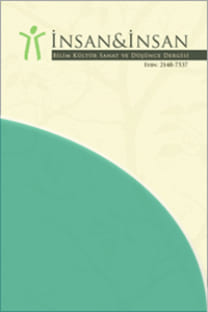J. S. Bach’ın Çello Süitlerine İlişkin Bir Literatür İncelemesi
J. S. Bach’ın eserleri el yazması veya kopya durumunda olup bu eserlerin bir kısmı kaybolmuştur. Bu durum, bestecinin ne istediğinin tam olarak bilinememesine neden olmakta ve eserlerinin yorumlanmasını daha da zorlaştırmaktadır. J. S. Bach’ın Çello Süitlerinin günümüze kadar ulaşan dört kopya el yazması bulunmaktadır. Bu eserlere ilişkin günümüze kadar ulaşmış otograf olan tek kaynak ise 5. süitin lavta transkripsiyonudur. Bu süitlerin otograflarının kayıp olması nedeniyle, ne zaman ve ne sürede yazıldıkları ancak tahminlere dayanmaktadır. Hakkında sahip olunan bilgilerin kısıtlı olması bir taraftan eserlerin yorumlanması konusunda belirsizliklere yol açsa da diğer taraftan zengin bir yorumlama anlayışı fırsatı sunmuştur. Bu bağlamda, bu çalışmanın amacı barok dönem içerisinde ve günümüzde J. S. Bach’ın çello süitlerinin yerini irdeleyerek bu eserlere ilişkin literatürü incelemektir.
Anahtar Kelimeler:
J. S. Bach, Çello süitleri, El Yazmaları
A Literature Review of J. S. Bach’s Cello Suites
The works of J. S. Bach are autographs or copies and some of them are lost. In this sense it is much more difficult for performers to know what the composer exactly wants. There are four manuscripts of J.S. Bach Cello Suites that has survived. The only source that has been reached to the present day is the autograph of the 5th suite’s lute transcription. Due to the missing autographs of these suites, when and for how long they were written is based on estimates. Limited and mysterious knowledge of these works cause uncertainty about the interpretation, but on the other hand, it offered a substantial sense of interpretation. In this sense, the aim of this study is to examine the literature about the role of the J. S. Bach cello suites in the Baroque period and in the present.
Keywords:
J. S. Bach, Cello suites, Manuscripts,
___
- Bangert, Daniel, Dorottoya Fabian, Emery Schubert ve Daniel Yeadon. “Performing Solo Bach: A Case Study of Musical Decision-making”. Musicæ Scientiæ. 18/1 (2014): 35-52.
- Boran, İlke ve Kıvılcım Şenürkmez. Kültürel Tarih Işığında Çoksesli Batı Müziği. İstanbul: Yapı Kredi Yayınları, 2015.
- Brothers, Harlan J. “Intervallic Scaling in The Bach Cello Suites”. World Scientific. 17/4 (2009): 537–545.
- Chambers, Mark. “The “Mistuned” Cello: Precursors to J. S. Bach’s Suite V in C Minor for Unaccompanied Violoncello”. 1996.
- Davis, Nathan J. “The Baroque Violoncello and The Unaccompanied Cello- Suites of J. S. Bach, B.W.V. 1007-1012”. Doctor of Philosophy Dissertation. New York University School of Education, Health, Nursing, and Arts Professions, 1986.
- Dube, Michelle Clair. “Prelude of Suite V For Cello Solo By J. S. Bach: Options For Performance”. Doctor of Musical Arts Dissertation. Arizona University, 1993.
- Erden, Evin. “J. S. Bach’ın Çello Süitlerinin El Yazmaları ve Farklı Edisyonlarının Karşılaştırılması”. Sanatta Yeterlik Tezi. Yaşar Üniversitesi, 2015.
- Feridunoğlu, Lale. İz Bırakan Besteciler Yaşamları ve Yapıtları. İstanbul: İnkılap Kitabevi, 2005.
- Green, Curtis. “A Comparison of Selected Editions of Bach’s Suite No. 5 in C”. Master of Music Thesis. Ball State University, 2009.
- Hill, Andrew John. “A Critical Investigation and Re-Assessment of The Composition History of J. S. Bach’s 5th Suite for Unaccompanied Violoncello BWV 1011”. PhD Thesis. The Open University, 2011.
- Hong, Ju-Lee. “Investigating Expressive Timing and Dynamics in Recorded Cello Performance. Society for Education”. Music and Psychology Research. 31/3 (2003): 340-352.
- Jarwis, Martin W. B. “Did Johann Sebastian Bach Write The Six Cello Suites?”. PhD Thesis. Faculty of Law Charles Darwin University, 2007.
- Karakelle, Tayfun. “Johann Sebastian Bach Viyolonsel Süitlerinin İncelenmesi”. Yüksek Lisans Tezi. Gazi Üniversitesi, 2006.
- Kıran, Sezgi Sevi. “J. S. Bach’ın Viyolonsel Süitlerinin Yorumlarında Farklı Edisyonların Etkileri”, Sanatta Yeterlik Tezi. Afyon Kocatepe Üniversitesi, 2012.
- Kramer, Laura Elizabeth. “Articulation in Johann Sebastian Bach’s Six Suites for Violoncello Solo (BWV 1007-1012): History, Analysis and Performance”. Doctor of Musical Arts Dissertation. Cornell University, 1998.
- Lawrence, Meredith. “The Influence of the Unaccompanied Bach Suites”. Proceedings of the National Conference On Undergraduate Research. Weber State University, 2012.
- Lim, Jungmook. “A Perfomance Guide to J.S. Bach’s Suite No. 5 For Violoncello Solo: The Interpretation of The Ornaments, Rhythm, Bowing and Phrasing, and Polyphonic Texture”. Doctor of Musical Arts Dissertation. University of Cincinnati, 2004.
- Markovic, Nemanja. “The Interpretation of The Fifth Cello Suite BWV 1011 by Johann Sebastian Bach (1685-1750). Master Thesis. Agder University, 2009.
- Michels, Ulrich ve Gunter Vogel. Müzik Atlası. Çev. Semih Uçar. İstanbul: Alfa Basım Yayım Dağıtım, 2013.
- Pridle, Daniel E. “The Form of The Preludes To Bach’s Unaccompanied Cello Suites”. Master Thesis. University of Massachusetts Amherst, 2011.
- Schonberg, Harold. Büyük Besteciler. Çev., Ahmet Fethi Yıldırım. İstanbul: Doğan Egmont Yayıncılık, 2013.
- Schwemer, Bettina ve Doaglas Woodfull-Harisson. 6 Suites a Violoncello Solo senza Basso BWV 1007-1012. Kassel: Bärenreiter, 2014.
- Sherwin, Jason Samuel ve Paul Sajda. “Musical Experts Recruit Action-Related Neural Structures in Harmonic Anomaly Detection: Evidence For Embodied Cognition in Expertise”. Brain and Cognition, 83/2 (2013): 190–202.
- Siblin, Eric. The Cello Suites: J. S. Bach, Pablo Casals and The Search for a Baroque Masterpiece. New York: Atlantic Monthly Press, 2009.
- Sung, Alistair ve Dorottya Fabian. “Variety in Performance: A Comparative Analysis of Recorded Performances of Bach’s Sixth Suite for Solo Cello from 1961 to 1998”. Empirical Musicology. 6/1 (2011): 20-42.
- Winold, Allen. Bach’s Cello Suites Analyses and Explorations Volume I: Text. Bloomingtom, Indianapolis: Indiana University Press, 2007.
- Yayın Aralığı: Yılda 2 Sayı
- Başlangıç: 2014
- Yayıncı: Okur Yazar Derneği
Sayıdaki Diğer Makaleler
Terörle Mücadele Kanunu’na Göre Mutlak ve Nispi Terör Suçları
Türkiye Siyasetini Değerler Üzerinden Okumak: 14 Mayıs 1950 Seçimi
Benlik Saygısı ve Organ Bağışı Tutumu İlişkisi: Üniversite Öğrencileri Üzerine Bir Araştırma
Harun KIRILMAZ, Pelinsu Buket GÜLER
Kadın Hakları ve Algısının İdeolojik Örüntüsü: KADEM Örneği
Gelişmiş Batı Demokrasilerinde Sivil-Asker İlişkilerine Dair Farklı Çözümler
J. S. Bach’ın Çello Süitlerine İlişkin Bir Literatür İncelemesi
İslamî Devrim Nedir?: 1979 İran Örneği
Türkiye’de Ordu-Siyaset İlişkileri ve Askeri Darbelerin İdeolojik Kökenleri
Ebru Ağaoğlu Ercan, Nagihan Çakar Bikiç
